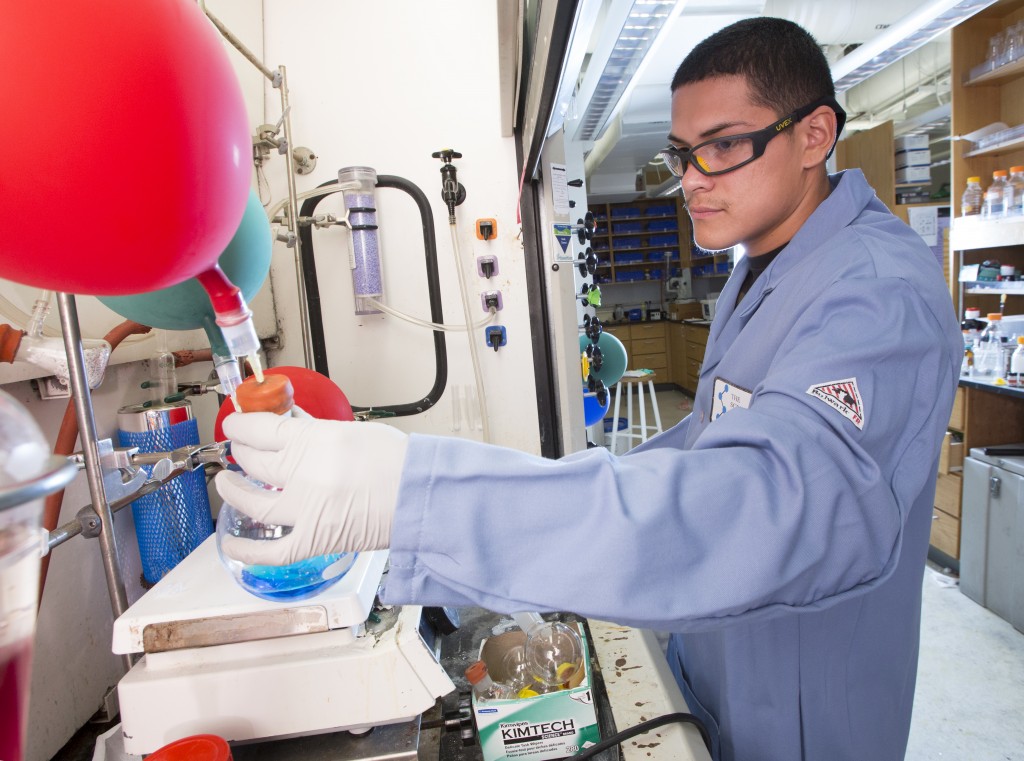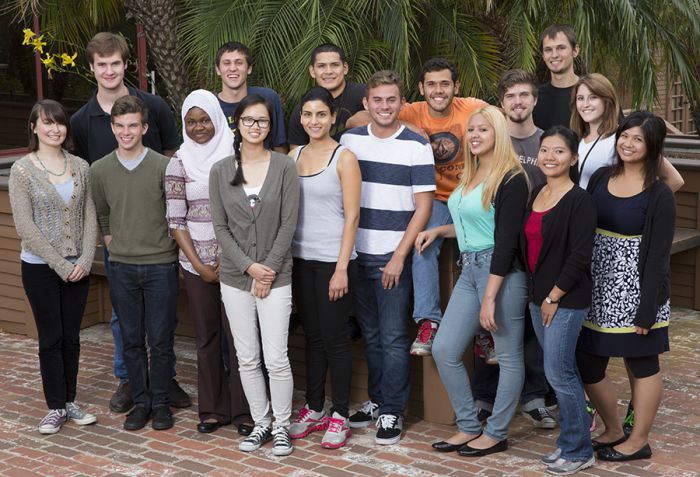
As many a student can attest, sometimes life gets in the way of school, thwarting goals and altering paths.
This was certainly the case for Cesar Deleon. He faced circumstances that could have jeopardized his education altogether, but instead he met those challenges head on, and with the help of the Minority Access to Research Careers (MARC) Undergraduate Student Training in Academic Research (USTAR) program the senior chemistry major at California State University, Dominguez Hills is preparing for graduate school, where he plans to specialize in organic chemistry with the goal of developing new medicine.
Although a bright kid, Deleon was not all that dedicated to his school work. An incident in which his little brother accidentally hit a municipal bus with a BB gun would change that. He took the blame to protect his brother and it nearly landed Deleon in juvenile hall. The brush with the law caused Deleon to reflect on his liberty, and he refocused his energy on school.
He excelled in math and science at Community Harvest Charter School, a now-shuttered Los Angeles Unified School District high school located in Sherman Oaks, and was also a gifted athlete who played and served as captain on the school’s varsity soccer team. But during his junior year of high school, Deleon learned that he and his girlfriend were going to be parents. Aspirations of going to college, let alone becoming a college athlete, seemed remote.
He also struggled in other subjects, and despite graduating with honors in math and science, he failed to meet admission requirements at CSU Dominguez Hills. Entering the university through the Educational Opportunity Program, however, he received remediation assistance the summer before his freshman year and made the cut. Still, he had serious considerations to make.
“When I got to college I decided that maybe sports isn’t the thing for me. I’ve got a child to think about. Can dedicating my first two years to being an athlete really help me find a stable career in the long run?” he asked himself.
He focused instead on becoming a doctor–inspired, in part, by the birth of his child. Initially choosing to major in biology, Deleon came to a realization while taking general chemistry courses that ultimately honed his career path.
“The reason for choosing medicine was because I wanted to help people. In science, I saw not only the opportunity to help people, but to help people beyond my generation,” he remarked.
There were also other good reasons to change his major to chemistry.
“I’ve always been in love with mathematics and using logic and critical thinking to solve problems. [Chemistry is] all about using math and applying the theory and concepts to try to solve the problem and I love the challenge of that,” he said. “And the fact that not a lot of people took up chemistry also made it an attractive major.”
Deleon remembers one of his university chemistry teachers telling students that among them only about five would earn an A grade in the class.
“I turned around to my neighbor and said, ‘Hey, that’s me, you, and another three people in here,’” he recalled. “I was very determined to try to get an A.”
Not only did he earn an A in the class, but he aced all of his general education chemistry courses, and now maintains a 3.91 GPA in the major.
Some of his teachers had noticed his inclination toward chemistry and suggested he consider pursuing it in a Ph.D. program.
“At that point, I didn’t know what a Ph.D. was. I didn’t even know there was a Ph.D. I just knew there was an M.D.,” he admitted.
After hearing a classroom presentation about the MARC USTAR program–funded by the National Institutes of Health (NIH) and aimed at supporting minority students in the biomedical and behavioral sciences to participate in high-caliber training in preparation for Ph.D. programs–he resolved to earn a doctoral degree in chemistry.
Now with two children to support, as well as their mother–his girlfriend–Deleon credits the two-year research scholarship he received in August 2011 from MARC USTAR for providing him an opportunity that would otherwise be out of his reach.

Scholars receive a monthly stipend, as well as funds for tuition fees, travel to conferences, and lab supplies. Now in his final year, Deleon is part of the NIH’s Research Initiative for Scientific Enhancement (RISE) program, which will take up where MARC USTAR left off, offering many of the same support activities.
“The financial support allowed me to focus on what I wanted to do, which was do research and excel in school.” Deleon added, “You can tell someone, ‘I can bring in $1,000 to your lab. I can supply my own equipment for the project that you’ll set up for me.’ It makes [students] more attractive and allows us to really choose our own mentors.”
The scholars have the opportunity to participate in workshops on topics from understanding the graduate school application process to writing a personal statement as well as learn from guest scientists.
“When someone from a different university who is at the forefront of chemistry visits, it gives us the opportunity to network with them and look for summer internships and opportunities that help us expand [our knowledge],” he noted.
Scholars are able to select a mentor who is working in the field, whether on or off campus. Deleon is opting to do research off campus during summer 2014 so he can continue to build his network and expand on the research and presentation experience he’s gained while at CSU Dominguez Hills.
Under the mentorship of assistant professor of chemistry and biochemistry and alumnus Kenneth Rodriguez (Class of ’01, B.S., chemistry), Deleon has garnered recognition at various events including a first-place award for his presentation of “Probing the Molecular Interaction and Orientation of Gramicidin Incorporated within a Supported Bilayer Lipid Membrane by Infrared Microscopy on Metallic Microarray Meshes” at the 2011 Annual Biomedical Research Conference for Minority Students (ABRCMS); and a second place award at the 2012 CSU Dominguez Hills Student Research Day in the chemistry category for his poster presentation on “Stacking of Metallic Microarray Meshes to Probe the Molecular Interaction and Orientation Structure of Gramicidin D Incorporated within Supported Bilayer Lipid Membranes by Infrared Microscopy.”
Deleon has also presented at the 2012 Biophysical Society Conference held in San Diego and to his peers during a biology senior seminar course (BIO491). He has participated in the 2013 Summer Undergraduate Research Fellows (SURF) program, which is a 10-week paid internship at the Scripps Research Institute in San Diego, and in a summer research program at The Ohio State University, where he learned to be a “cancer photographer,” using infrared light to identify cancer in the liver. In 2011 he attended a four-day Access symposium at the Massachusetts Institute of Technology.
Although receiving support for academic and scientific pursuits, Deleon knows he must be dedicated to the work in order to capitalize on opportunities presented.
“The beauty of the MARC USTAR program is that it actually puts you at the door of research,” he said. “It’s really up to you to go in and do what you have to do to be successful.”